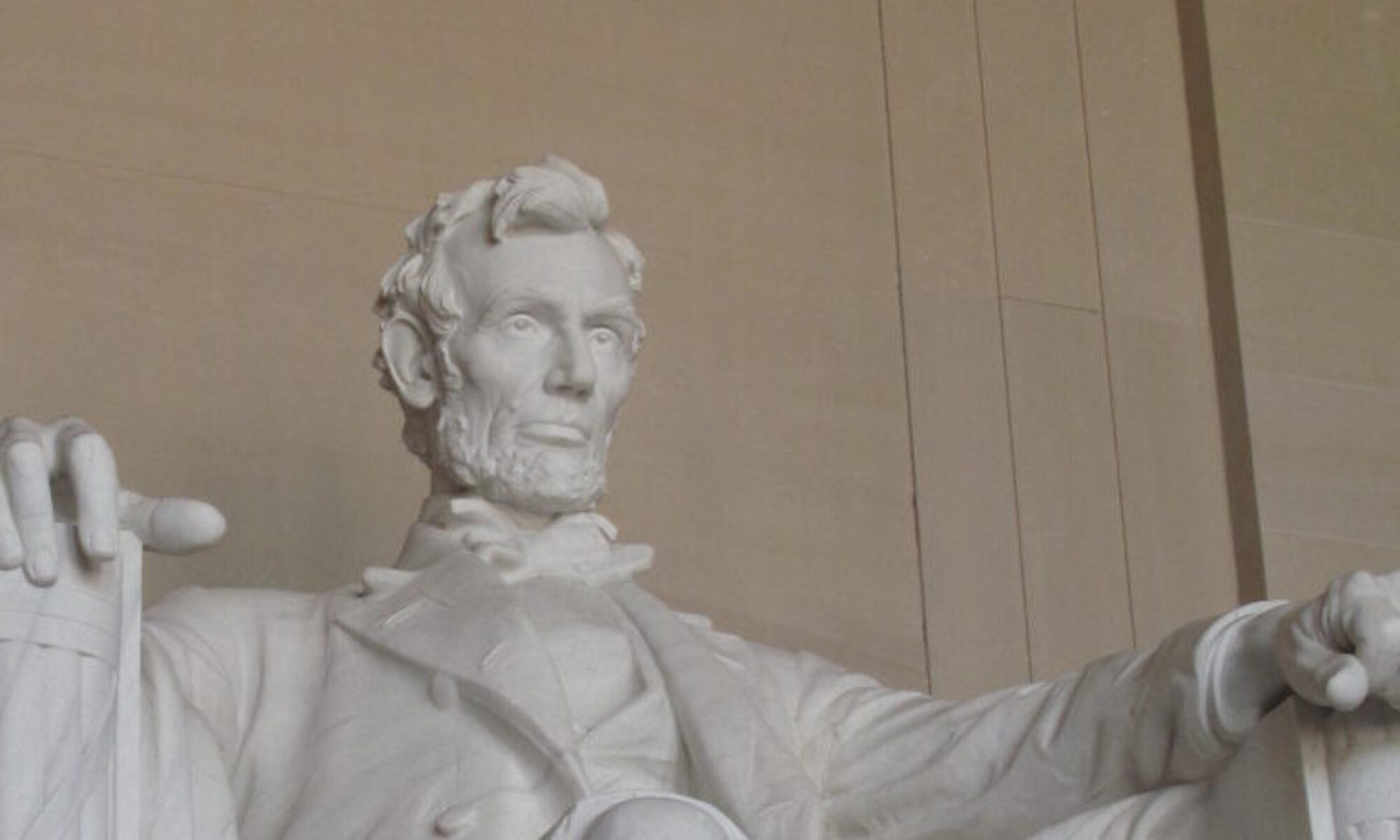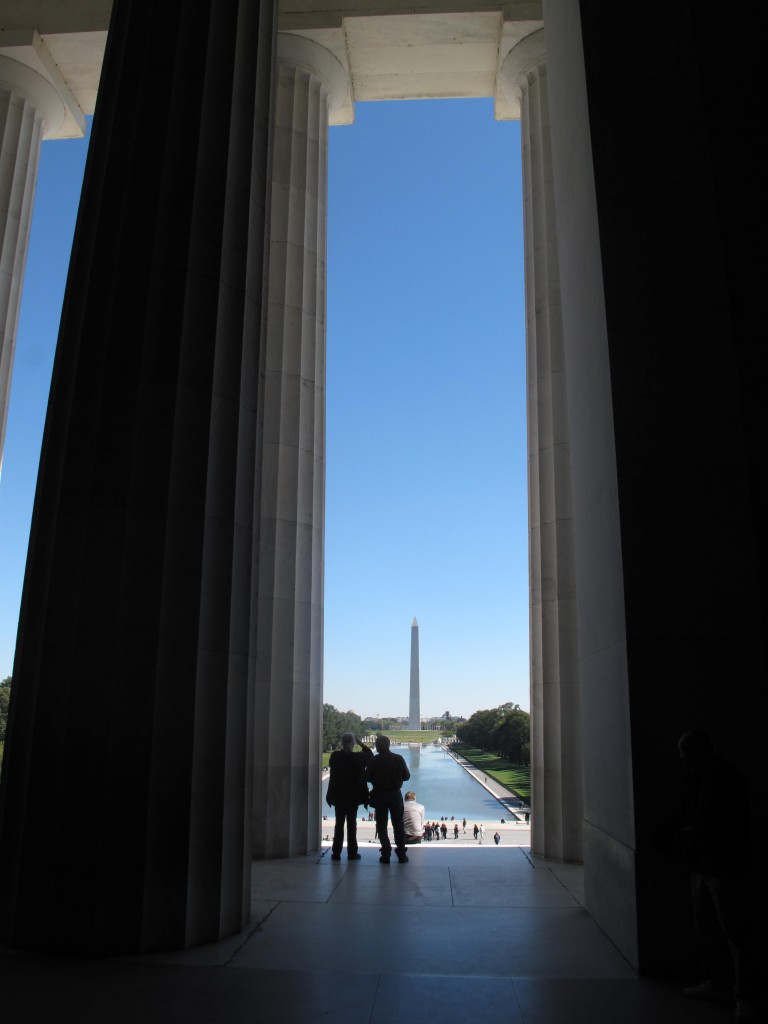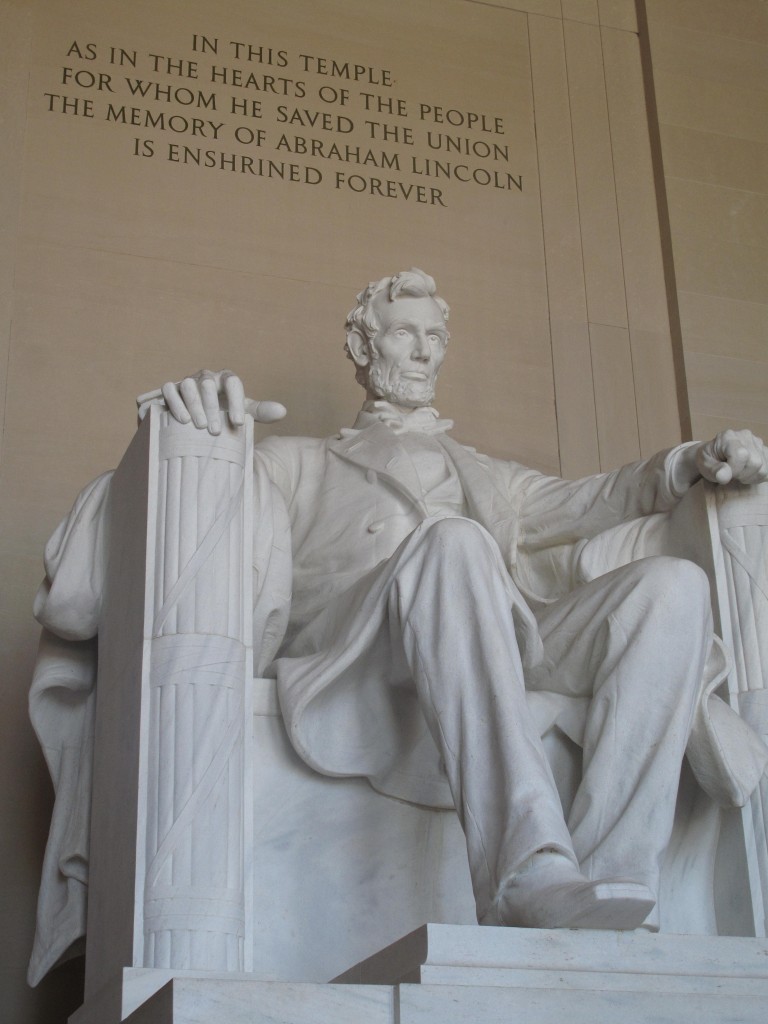 I had the occasion this past week to plum with some depth the national treasure that is our nation’s capital, Washington D.C. I had visited it some eighteen years before, but viewed the incredible wealth of venues as a quick aside to a business trip. I was determined this time, to absorb with more gravity, all I could physically reach on foot in three days, and despite only scratching the surface of what is available, was thrilled with what I saw, and frankly, emotionally moved by our nation’s story. Washington D.C. is not only the source of much of our history, it is the keeper of our historical flame, and no where is that more profoundly put in perspective than on the monuments that frame the National Mall.
I had the occasion this past week to plum with some depth the national treasure that is our nation’s capital, Washington D.C. I had visited it some eighteen years before, but viewed the incredible wealth of venues as a quick aside to a business trip. I was determined this time, to absorb with more gravity, all I could physically reach on foot in three days, and despite only scratching the surface of what is available, was thrilled with what I saw, and frankly, emotionally moved by our nation’s story. Washington D.C. is not only the source of much of our history, it is the keeper of our historical flame, and no where is that more profoundly put in perspective than on the monuments that frame the National Mall.
The epic story of the mall is framed by its immense bookends, the obelisk of the Washington Monument and the temple of the Lincoln Monument. There is no more dramatic tale to tell than that of the revolutionary leadership of Washington, who risked all to secure the improbable birth of a nation against the resources and will of the most 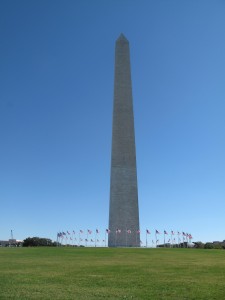 powerful nation on earth, a man who could have been King but refused, a man who recognized that he as a leader was the one indispensable component to securing a revolution, but as a man representing a true republic ruled by its people, critically and ultimately dispensable. The soaring obelisk reaches for the sky and approaches the heavens as fitting for nation’s father figure whose calm and steady demeanor in the face of incredible stresses and odds was Olympian in its majesty. At the other end of the reflecting pool, the massive temple to our national martyr Lincoln, seated solemnly contemplating the incredible sacrifice required to preserve the union and cleanse it of its greatest scourge, slavery.
powerful nation on earth, a man who could have been King but refused, a man who recognized that he as a leader was the one indispensable component to securing a revolution, but as a man representing a true republic ruled by its people, critically and ultimately dispensable. The soaring obelisk reaches for the sky and approaches the heavens as fitting for nation’s father figure whose calm and steady demeanor in the face of incredible stresses and odds was Olympian in its majesty. At the other end of the reflecting pool, the massive temple to our national martyr Lincoln, seated solemnly contemplating the incredible sacrifice required to preserve the union and cleanse it of its greatest scourge, slavery.  The two men, so different – the greatest landowner and wealthiest man in America, Washington, and the commoner Lincoln, borne of the most primitive circumstances and abject poverty in the Kentucky wilderness, arose to shared immortality as our nation’s greatest servants, bound by the foundation of an ideal that in this place called America all men could pursue their destiny with equal birthright and opportunity. Unique among monuments is the pronounced stillness of the crowds within the Lincoln Memorial, a quiet not of worship but of reverence, for the man and his profound understanding of his nation and the weight of the task he took upon himself to accomplish in order to preserve it.
The two men, so different – the greatest landowner and wealthiest man in America, Washington, and the commoner Lincoln, borne of the most primitive circumstances and abject poverty in the Kentucky wilderness, arose to shared immortality as our nation’s greatest servants, bound by the foundation of an ideal that in this place called America all men could pursue their destiny with equal birthright and opportunity. Unique among monuments is the pronounced stillness of the crowds within the Lincoln Memorial, a quiet not of worship but of reverence, for the man and his profound understanding of his nation and the weight of the task he took upon himself to accomplish in order to preserve it.
Centered now between the homage to the two great leaders of the nation is a memorial to the greatest shared challenge of the nation’s people, the World War II Monument. It balances beautifully the two great structures bracketing the reflecting pool, to celebrate a nation’s shared heroic will and sacrifice, rather than the individual warriors of the conflict. Each state and territory holds a place in the circle of honor for the commitment of lives and fortunes to the national engine of victory. 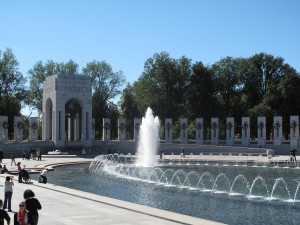 The individual battles provide only background context for the scope of the nation’s shared focus and contribution. Before I personally saw this monument I was somewhat doubtful as to how it would project such a complex and profound story in a place more occasioned to illuminate individual heroes. In person, it does so beautifully and in context with the surroundings and the streams of people visiting it speak to its success as a monument in a place of epic monuments.
The individual battles provide only background context for the scope of the nation’s shared focus and contribution. Before I personally saw this monument I was somewhat doubtful as to how it would project such a complex and profound story in a place more occasioned to illuminate individual heroes. In person, it does so beautifully and in context with the surroundings and the streams of people visiting it speak to its success as a monument in a place of epic monuments.
Just off the reflecting pool are other reverent displays of our nation’s battles. The Vietnam Memorial has become legendary for its starkness and its solemn focus on the individual sacrifice, as evidenced by the mirrored listing of each dead soldier sacrificed in what was, until Afghanistan, our nation’s longest war. Lesser known, but equally moving is the Korean War Memorial,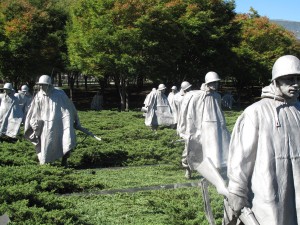 that takes a slightly different approach to the individual American sacrifice, in a war of shorter length but perhaps more brutal and intense fighting. A platoon of soldiers wordlessly exits out of a stand of trees, warily searching the horizon and each contemplating the potential dangers, yet marching onward nevertheless. To the side, a polished granite wall has thousands of ghostlike etchings of the faces
that takes a slightly different approach to the individual American sacrifice, in a war of shorter length but perhaps more brutal and intense fighting. A platoon of soldiers wordlessly exits out of a stand of trees, warily searching the horizon and each contemplating the potential dangers, yet marching onward nevertheless. To the side, a polished granite wall has thousands of ghostlike etchings of the faces 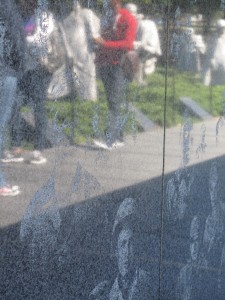 of the conflict that touch so many lives, yet is lost in historical perspective between the immensity of the war that preceded it and the controversy of the war that succeeded it. On this particular day, a wreath of flowers from the Republic of South Korea showed the mists of time have not diminished this nation’s recognition of what role America played in preserving their independence and ongoing prosperity.
of the conflict that touch so many lives, yet is lost in historical perspective between the immensity of the war that preceded it and the controversy of the war that succeeded it. On this particular day, a wreath of flowers from the Republic of South Korea showed the mists of time have not diminished this nation’s recognition of what role America played in preserving their independence and ongoing prosperity.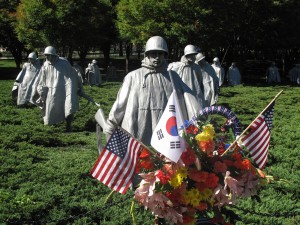
As one leaves the Mall for the Tidal Basin, the Mall’s symbolic reflection of national struggles are now left behind to return to the epic adoration of individuals on a massive canvas. The newest is the Martin Luther King Memorial at the crest of the Tidal Basin. 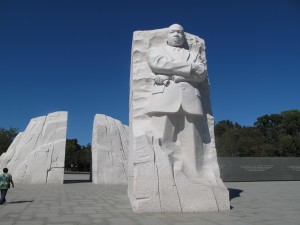 One walks between the cleft of a marble mountain to confront a man emerging out of stone, with a look of resoluteness and determination convinced of the righteousness of his cause. Despite the structure’s almost “soviet” overtones, there is a real sense of this man’s capacity to confront and overcome human inequities with the power of his intellect and logic that speaks to Mr. King’s critical place in the American story and the overwhelming propriety to place his presence among America’s pantheon of heroes. A mild complaint is the selection of a relatively political nature of his quotations, rather than the multiple magnificent quotations that spoke to his universality – I guess this should come as no surprise in today’s more politically correct world. From the King Memorial, one travels the Basin to the monumental Franklin Delano Roosevelt Memorial, huge in scope and story, highlighting the President’s leadership framing his most famous statements against the pain of the Great Depression and the challenge of the colossal World War.
One walks between the cleft of a marble mountain to confront a man emerging out of stone, with a look of resoluteness and determination convinced of the righteousness of his cause. Despite the structure’s almost “soviet” overtones, there is a real sense of this man’s capacity to confront and overcome human inequities with the power of his intellect and logic that speaks to Mr. King’s critical place in the American story and the overwhelming propriety to place his presence among America’s pantheon of heroes. A mild complaint is the selection of a relatively political nature of his quotations, rather than the multiple magnificent quotations that spoke to his universality – I guess this should come as no surprise in today’s more politically correct world. From the King Memorial, one travels the Basin to the monumental Franklin Delano Roosevelt Memorial, huge in scope and story, highlighting the President’s leadership framing his most famous statements against the pain of the Great Depression and the challenge of the colossal World War. 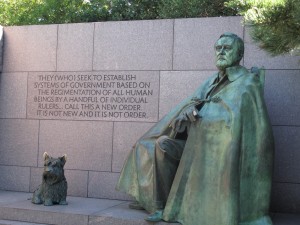 The most significant statue is that of a war weary President comforted by his dog Fala, as he gazes back on the huge events that bookended his three terms and four elections as America’s longest serving President. The most poignant is a line of hungry, desperate men leading to a door that suggests an unemployment or perhaps food line that underscores the devastating effects on the nation in the torment of financial and personal collapse.
The most significant statue is that of a war weary President comforted by his dog Fala, as he gazes back on the huge events that bookended his three terms and four elections as America’s longest serving President. The most poignant is a line of hungry, desperate men leading to a door that suggests an unemployment or perhaps food line that underscores the devastating effects on the nation in the torment of financial and personal collapse. We could certainly take some heed as we approach our own generation’s approaching fiscal crisis with a currently casual nature that it was not so long ago that an equally confident America succumbed to a financial calamity.
We could certainly take some heed as we approach our own generation’s approaching fiscal crisis with a currently casual nature that it was not so long ago that an equally confident America succumbed to a financial calamity.
The Tidal Basin than completes its beautiful circularity, populated by beautiful cherry trees, with the appropriately cool and isolated Thomas Jefferson Memorial and the tiny and unfortunately neglected George Mason Memorial. These colossal intellects of the American Revolution, Jefferson, the supreme poet of the Declaration of Independence and Mason, the Father of the Bill of Rights and intellectual framer of the Constitution have surprisingly unequal treatments. Thomas Jefferson peers across the Basin detached from his heroic compatriots on the Mall, his elevated words providing the cool logic and intellectual force of the Revolution, 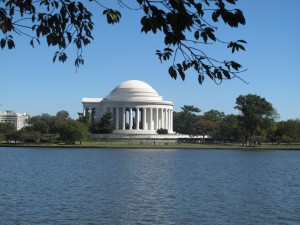 rather than participating the calamity directly as a military man as did so many of his fellow Virginians.
rather than participating the calamity directly as a military man as did so many of his fellow Virginians. 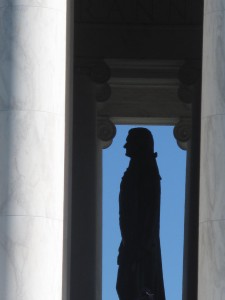 The memorial building so beautifully reflective of Jerfferson’s own Monticello stands in stark contrast to the little garden trellis that hovers over George Mason, seated at a bench like a country gentleman rather than the intellectual force he was.
The memorial building so beautifully reflective of Jerfferson’s own Monticello stands in stark contrast to the little garden trellis that hovers over George Mason, seated at a bench like a country gentleman rather than the intellectual force he was. It is one of the peculiarities of history that unfolding of the story is not always weighted by the profoundness of the contribution but rather the perspective of the story teller – thus the relative neglect of the great contributors to the nation’s birth, John Adams and George Mason.
It is one of the peculiarities of history that unfolding of the story is not always weighted by the profoundness of the contribution but rather the perspective of the story teller – thus the relative neglect of the great contributors to the nation’s birth, John Adams and George Mason.
The return to the National Mall from the Tidal Basin completes the circle of history as memorialized in stone and sculpture. On a beautiful day like the one I appreciated above, the memorials exult in a special magnificence of scale and profundity. We are reminded that our heroes have reached national veneration not so much through their circumstances as much as their selfless actions. They are immortalized for the eternal validity of their ideas and clarity of purpose by which they made such lofty ideas actionable. In this nation of common birth, the most uncommon brilliance has sprung forth.
